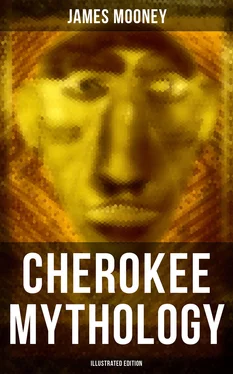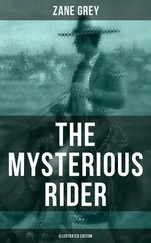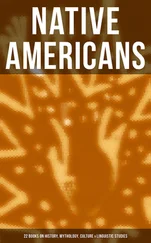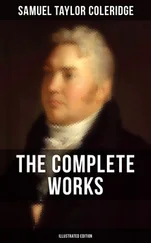James Mooney
Cherokee Mythology
(Illustrated Edition)
Published by

Books
- Advanced Digital Solutions & High-Quality eBook Formatting -
musaicumbooks@okpublishing.info
2018 OK Publishing
ISBN 978-80-272-4581-9
I. Introduction
II. Historical Sketch of the Cherokee
The Traditionary Period
The Period of Spanish Exploration—1540–?
The Colonial and Revolutionary Period—1654–1784
Relations with the United States
From the First Treaty to the Removal—1785–1838
The Removal—1838–39
The Arkansas Band—1817–1838
The Texas Band—1817–1900
The Cherokee Nation in the West—1840–1900
The Eastern Band
III. Notes to the Historical Sketch
IV. Stories and Story Tellers
V. The Myths
Cosmogonic Myths
1. How the World was Made
2. The First Fire
3. Kana′tĭ and Selu: The Origin of Game and Corn
4. Origin of Disease and Medicine
5. The Daughter of the Sun
6. How They Brought Back the Tobacco
7. The Journey to the Sunrise
8. The Moon and the Thunders
9. What the Stars are Like
10. Origin of the Pleiades and the Pine
11. The Milky Way
12. Origin of Strawberries
13. The Great Yellow-jacket: Origin of Fish and Frogs
14. The Deluge
Quadruped Myths
15. The Fourfooted Tribes
16. The Rabbit Goes Duck Hunting
17. How the Rabbit Stole the Otter’s Coat
18. Why the Possum’s Tail is Bare
19. How the Wildcat Caught the Gobbler
20. How the Terrapin Beat the Rabbit
21. The Rabbit and the Tar Wolf
22. The Rabbit and the Possum After a Wife
23. The Rabbit Dines the Bear
24. The Rabbit Escapes from the Wolves
25. Flint Visits the Rabbit
26. How the Deer Got His Horns
27. Why the Deer’s Teeth are Blunt
28. What Became of the Rabbit
29. Why the Mink Smells
30. Why the Mole Lives Underground
31. The Terrapin’s Escape from the Wolves
32. Origin of the Groundhog Dance: The Groundhog’s Head
33. The Migration of the Animals
34. The Wolf’s Revenge—The Wolf and the Dog
Bird Myths
35. The Bird Tribes
36. The Ball Game of the Birds and Animals
37. How the Turkey Got His Beard
38. Why the Turkey Gobbles
39. How the Kingfisher Got His Bill
40. How the Partridge Got His Whistle
41. How the Redbird Got His Color
42. The Pheasant Beating Corn; Origin of the Pheasant Dance
43. The Race Between the Crane and the Hummingbird
44. The Owl Gets Married
45. The Huhu Gets Married
46. Why the Buzzard’s Head is Bare
47. The Eagle’s Revenge
48. The Hunter and the Buzzard
Snake, Fish, and Insect Myths
49. The Snake Tribe
50. The Uktena and the Ulûñsû′tĭ
51. Âgăn-uni′tsĭ’s Search for the Uktena
52. The Red Man and the Uktena
53. The Hunter and the Uksu′hĭ
54. The Ustû′tlĭ
55. The Uwʼtsûñ′ta
56. The Snake Boy
57. The Snake Man
58. The Rattlesnake’s Vengeance
59. The Smaller Reptiles—Fishes and Insects
60. Why the Bullfrog’s Head is Striped
61. The Bullfrog Lover
62. The Katydid’s Warning
Wonder Stories
63. Ûñtsaiyĭ′, The Gambler
64. The Nest of the Tlă′nuwă
65. The Hunter and the Tlă′nuwă
66. Uʻtlûñ′tă, The Spear-finger
67. Nûñ′yunu′wĭ, The Stone Man
68. The Hunter in the Dăkwă′
69. Atagâ′hĭ, The Enchanted Lake
70. The Bride from the South
71. The Ice Man
72. The Hunter and Selu
73. The Underground Panthers
74. The Tsundige′wĭ
75. Origin of the Bear: The Bear Songs
76. The Bear Man
77. The Great Leech of Tlanusi′yĭ
78. The Nûñnĕ′hĭ and Other Spirit Folk
79. The Removed Townhouses
80. The Spirit Defenders of Nĭkwăsĭ′
81. Tsulʻkălû′, The Slant-eyed Giant
82. Kăna′sta, The Lost Settlement
83. Tsuwe′năhĭ: A Legend of Pilot Knob
84. The Man Who Married the Thunder’s Sister
85. The Haunted Whirlpool
86. Yahula
87. The Water Cannibals
Historical Traditions
88. First Contact with Whites
89. The Iroquois Wars
90. Hiadeoni, The Seneca
91. The Two Mohawks
92. Escape of the Seneca Boys
93. The Unseen Helpers
94. Hatcinoñdoñ’s Escape from the Cherokee
95. Hemp-carrier
96. The Seneca Peacemakers
97. Origin of the Yontoñwisas Dance
98. Gaʼna’s Adventures Among the Cherokee
99. The Shawano Wars
100. The Raid on Tĭkwăli′tsĭ
101. The Last Shawano Invasion
102. The False Warriors of Chilhowee
103. Cowee Town
104. The Eastern Tribes
105. The Southern and Western Tribes
106. The Giants from the West
107. The Lost Cherokee
108. The Massacre of the Ani′-kuta′nĭ
109. The War Medicine
110. Incidents of Personal Heroism
111. The Mounds and the Constant Fire: The Old Sacred Things
Miscellaneous Myths and Legends
112. The Ignorant Housekeeper
113. The Man in the Stump
114. Two Lazy Hunters
115. The Two Old Men
116. The Star Feathers
117. The Mother Bear’s Song
118. Baby Song, To Please the Children
119. When Babies are Born: The Wren and the Cricket
120. The Raven Mocker
121. Herbert’s Spring
122. Local Legends of North Carolina
123. Local Legends of South Carolina
124. Local Legends of Tennessee
125. Local Legends of Georgia
126. Plant Lore
Notes and Parallels to Myths
Glossary of Cherokee Words

PL. I
PHOTOGRAPH BY AUTHOR, 1888
IN THE CHEROKEE MOUNTAINS
Table of Contents
The myths given in this paper are part of a large body of material collected among the Cherokee, chiefly in successive field seasons from 1887 to 1890, inclusive, and comprising more or less extensive notes, together with original Cherokee manuscripts, relating to the history, archeology, geographic nomenclature, personal names, botany, medicine, arts, home life, religion, songs, ceremonies, and language of the tribe. It is intended that this material shall appear from time to time in a series of papers which, when finally brought together, shall constitute a monograph upon the Cherokee Indians. This paper may be considered the first of the series, all that has hitherto appeared being a short paper upon the sacred formulas of the tribe, published in the Seventh Annual Report of the Bureau in 1891 and containing a synopsis of the Cherokee medico-religious theory, with twenty-eight specimens selected from a body of about six hundred ritual formulas written down in the Cherokee language and alphabet by former doctors of the tribe and constituting altogether the largest body of aboriginal American literature in existence.
Although the Cherokee are probably the largest and most important tribe in the United States, having their own national government and numbering at any time in their history from 20,000 to 25,000 persons, almost nothing has yet been written of their history or general ethnology, as compared with the literature of such northern tribes as the Delawares, the Iroquois, or the Ojibwa. The difference is due to historical reasons which need not be discussed here.
Читать дальше














